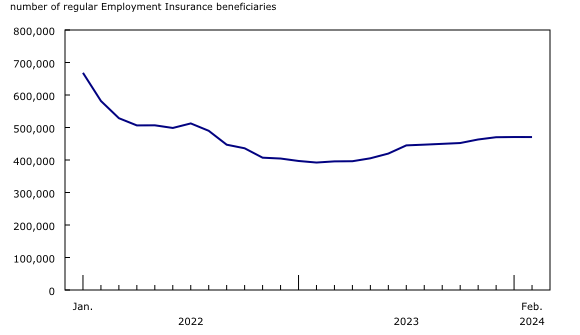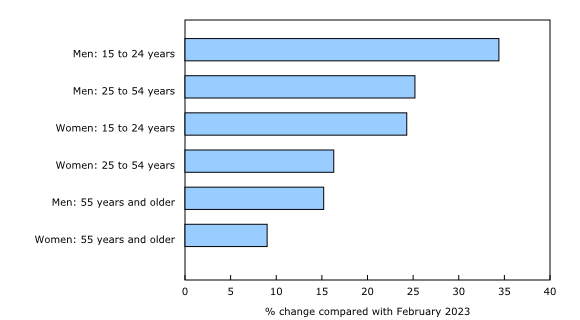Employment Insurance, February 2024
Released: 2024-04-18
The number of Canadians receiving regular Employment Insurance (EI) benefits was virtually unchanged in February and stood at 471,000. Following a net increase of 49,000 from April to July 2023, the number of regular EI beneficiaries has remained relatively stable in recent months.
Data from the Labour Force Survey (LFS) show that the unemployment rate remained at 5.8% for three of the four months leading up to February 2024. This stability follows an upward trend from April to November 2023, when the unemployment rate increased from 5.1% to 5.8%.
In general, variations in the number of EI beneficiaries can reflect changes in the circumstances of different groups, including those becoming beneficiaries, those going back to work, those exhausting their regular benefits, and those no longer receiving benefits for other reasons.
More youth receive regular Employment Insurance benefits in February
The number of youth (aged 15 to 24) receiving regular EI benefits increased for the fourth consecutive month in February, up 900 (+2.0%) in the month. The increase was split between young women (+500; +3.5%) and young men (+400; +1.4%). In the 12 months to February, the number of regular EI recipients increased faster among young men (+8,400; +34.4%) than among young women (+2,600; +24.3%). Over the same period, LFS data show that the unemployment rate rose by 1.2 percentage points to 12.0% for young men and by 1.8 percentage points to 11.1% among young women.
In February, the number of core-aged men (25 to 54 years old) receiving regular EI benefits decreased by 3,400 (-1.8%), the first significant decline since February 2023. Meanwhile more core-aged women (+1,800; +1.6%) received regular EI benefits in February 2024, the third increase in the past four months. On a year-over-year basis, more core-aged men (+37,000; +25.2%) and core-aged women (+16,000; +16.3%) received regular EI benefits in February.
The number of regular EI recipients was little changed for the second consecutive month in February among men and women aged 55 and older. However, on a year-over-year basis, there were 11,000 (+15.2%) more older men and 3,900 (+9.0%) additional older women receiving regular EI benefits.
Fewer regular Employment Insurance recipients in British Columbia and more in Ontario
The number of regular EI beneficiaries fell in British Columbia in February, while it increased in Ontario. There was little change in the other provinces.
The number of regular EI recipients in British Columbia fell by 1,500 (-2.9%) in February, the second decrease in three months. This decline follows a net increase of 13,000 (+33.2%) from May to November 2023 in the province. Declines in February 2024 were observed among core-aged men (-700; -3.4%), older men (-600; -7.8%) and older women (-100; -2.7%). The Vancouver census metropolitan area (CMA) posted a decline in the total number of people receiving regular EI benefits (-900; -3.9%) in February.
In Ontario, the number of regular EI beneficiaries increased by 1,400 (+1.0%) in February, continuing an upward trend that began in December 2022, with cumulative increases totalling 39,000 (+36.5%). Over the period, the LFS showed that the provincial unemployment rate increased from 5.3% in December 2022 to 6.5% in February 2024.
The largest increase in regular EI recipients in Ontario in February was among men aged 55 and older (+1,300; +7.0%), with smaller increases among youth (+700; +5.2%) and core-aged women (+500; +1.3%). Meanwhile, fewer core-aged men (-1,100; -1.9%) received regular EI benefits in the month.
Among CMAs in Ontario, the number of regular EI recipients increased the most in Toronto (+1,100; +1.8%), while the largest decrease was in Hamilton (-900; -11.3%).
Did you know we have a mobile app?
Download our mobile app and get timely access to data at your fingertips! The StatsCAN app is available for free on the App Store and on Google Play.
Sustainable Development Goals
On January 1, 2016, the world officially began implementing the 2030 Agenda for Sustainable Development—the United Nations' transformative plan of action that addresses urgent global challenges over the following 15 years. The plan is based on 17 specific sustainable development goals.
Employment Insurance statistics are an example of how Statistics Canada supports reporting on global sustainable development goals. This release will be used to help measure the following goal:

Note to readers
Availability of data by occupation
Statistics Canada is currently revising the Employment Insurance Statistics (EIS) data to conform to the 2021 National Occupational Classification (NOC) standard. This will result in EIS occupation categories aligning with the 2021 Census of Population and Labour Force Survey NOC 2021 categories. The release of revised data is planned for later in 2024. Until then, information on Employment Insurance (EI) beneficiaries by occupation, including tables 14-10-0336-01 and 14-10-0337-01, will not be available.
Concepts and methodology
EI statistics are produced from administrative data sources provided by Service Canada and Employment and Social Development Canada. These statistics may, from time to time, be affected by changes to the Employment Insurance Act or administrative procedures.
EI statistics indicate the number of people who received EI benefits and should not be confused with Labour Force Survey (LFS) data, which provide estimates of the total number of unemployed people. There is always a certain proportion of unemployed people who do not qualify for benefits. Some unemployed people have not contributed to the program because they have not worked in the past 12 months or their employment was not insured. Other unemployed people have contributed to the program, but do not meet the eligibility criteria, such as workers who left their jobs voluntarily or those who did not accumulate enough hours of work to receive benefits.
All data in this release are seasonally adjusted, unless otherwise specified. To model the effects of the COVID-19 pandemic, values for all series from March 2020 to November 2021 have been treated with a combination of level shifts and outliers to determine a seasonal pattern for seasonal adjustment. For more information on seasonal adjustment, see Seasonally adjusted data – Frequently asked questions.
The number of regular EI beneficiaries for the current month and the previous month is subject to revision.
The number of beneficiaries is all people who received regular EI benefits from February 11 to 17, 2024. This period coincides with the reference week of the LFS.
A census metropolitan area (CMA) and a census agglomeration (CA) are formed by one or more adjacent municipalities centred on a population centre. A CMA must have a total population of at least 100,000. A CA must have a population of at least 10,000. See Standard Geographical Classification 2016 – Definitions for more information.
Next release
Data on EI for March will be released on May 23.
Products
More information about the concepts and use of Employment Insurance statistics is available in the Guide to Employment Insurance Statistics (73-506-G).
Contact information
For more information, or to enquire about the concepts, methods or data quality of this release, contact us (toll-free 1-800-263-1136; 514-283-8300; infostats@statcan.gc.ca) or Media Relations (statcan.mediahotline-ligneinfomedias.statcan@statcan.gc.ca).
- Date modified:




